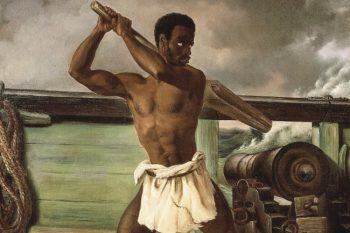Greg Grandin in The Chronicle of Higher Education:
 On a late February day in 1805 in the South Pacific, Amasa Delano, master of the Perseverance, a sealer out of Boston, boarded a distressed Spanish ship carrying about 70 West African men, women, and children. Delano spent about nine hours on the vessel, called the Tryal. He talked with its sailors, who were few in number, doled out water to its black-skinned men and women, and took charge of organizing repairs. And all that time, he couldn’t see that it was the West Africans, whom he thought were slaves, and not the Spaniard who introduced himself as captain, who were in command. Nearly two months earlier, the West Africans, who had been loaded at Valparaiso, Chile, bound to be sold in Lima, rose up, executing most of the Tryal’s crew and passengers, along with the slave trader who was taking them to Peru. Led by an elderly man named Babo and his son Mori, the rebels ordered Benito Cerreño, the ship’s owner and captain, to sail them to Senegal.
On a late February day in 1805 in the South Pacific, Amasa Delano, master of the Perseverance, a sealer out of Boston, boarded a distressed Spanish ship carrying about 70 West African men, women, and children. Delano spent about nine hours on the vessel, called the Tryal. He talked with its sailors, who were few in number, doled out water to its black-skinned men and women, and took charge of organizing repairs. And all that time, he couldn’t see that it was the West Africans, whom he thought were slaves, and not the Spaniard who introduced himself as captain, who were in command. Nearly two months earlier, the West Africans, who had been loaded at Valparaiso, Chile, bound to be sold in Lima, rose up, executing most of the Tryal’s crew and passengers, along with the slave trader who was taking them to Peru. Led by an elderly man named Babo and his son Mori, the rebels ordered Benito Cerreño, the ship’s owner and captain, to sail them to Senegal.
Cerreño stalled, cruising first north and then south, before running into the Perseverance.The rebels began to ready their weapons for a fight. But then Babo had an idea.
The West Africans let Delano come on board and acted as if they were still slaves. Mori stayed at Cerreño’s side and feigned at being a humble and devoted servant. Cerreño pretended he was still in charge, telling Delano stories about storms, doldrums, and fevers to account for the state of his ship and the absence of any officer aside from himself. The alabaster-skinned Delano later wrote that he found himself surrounded by scores of Africans and a handful of Spanish and mulatto sailors telling their “stories” and sharing their “grievances” in a babel of languages. They spoke in Wolof, Mandinka, Fulani, and Spanish, a rush of words indecipherable in its details but soothing to Delano in its generalities, convincing the New Englander that the desperation he was witnessing was real, that he wasn’t being lured into a pirate’s trap.
Over the years, this remarkable affair—in effect, a one-act, nine-hour, full-cast pantomime of the master-slave relation performed by a group of desperate, starving, and thirsty men and women—has inspired writers, poets, and novelists. The Chilean poet Pablo Neruda thought the boldness of the slaves reflected the dissent of the 1960s. More recently the Uruguayan Tomás de Mattos’s Chinese box of a novel, La fragata de las máscaras, uses the deception as a metaphor for a world where reality isn’t hidden behind a mask but is the mask itself.
But by far the most haunting rendition of the events on the Tryal is Herman Melville’s Benito Cereno, first published in 1855. Melville left no letters or diaries, at least none yet found, that reveal his thoughts upon reading Delano’s memoir, or what had moved him to fictionalize Delano’s experience on board the rebel-held ship. But by the 1850s, Melville had become preoccupied with the sham of modern life, with the difficulty of distinguishing surface appearance from substance. So it isn’t hard to imagine what attracted him to the incident, and particularly to the duped Delano.
More here. (Note: Throughout February, we will publish at least one post dedicated to Black History Month)
